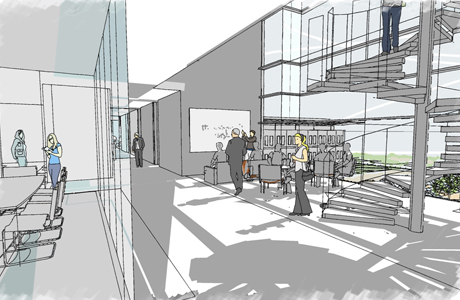The most fruitful conversations, innovative developments, and creative solutions often occur almost by accident. People are talking over lunch and suddenly, ideas fly.
 The Engineering Education and Research Center will be designed to encourage ideas to soar.
The Engineering Education and Research Center will be designed to encourage ideas to soar."That's not something you can do by email or having meetings," said Gary Pope, director, Center for Petroleum and Geosystems Engineering. "People need to interact, and to do that, they need to be close together." Proximity becomes more important when collaborators come from different disciplines, he added.
The new Engineering Education and Research Center will foster interaction and collaboration with flexible and progressive space for teaching and interdisciplinary research initiatives. One example is the Center for Frontiers of Subsurface Energy Security, a $15.5 million, five-year effort to explain the movement and transport of greenhouse gases in geological systems. Funded by a U.S. Department of Energy grant and led by Pope, this involves an interdisciplinary team from the university's Cockrell School and Jackson School of Geosciences along with Sandia National Laboratories in New Mexico.
"We have a very compatible, motivated team, but the language and culture and understanding across these widely different disciplines is significant," Pope said. "We're trying to tie together things ranging from a microscopic level to thousands of meters, and over a thousand-year time scale. It's never been done before and it's a daunting task. To make reliable, accurate predictions of what will happen, we have to understand other members of the team. You can't just throw everything into the computer and grind out an answer. We need to think about emergent phenomena. It is going to take better collaboration than ever before."
A well-designed space enhances effective collaboration, Pope believes. Places for people to sit down together comfortably and talk, relatively free of distractions and interruptions, are key. Offices, meeting rooms, and labs all need to be in close proximity.
"In my experience, those 'ah ha' moments, the breakthroughs, happen when people come up with something together that they would not have individually," he said. "It usually happens in an informal, spontaneous atmosphere, almost never in formal, structured meetings. Informal interaction is really important and under-rated by people who don't do academic research or haven't done it for a long time.
"Sometimes you just need to go in the lab together and touch things and look at things close up. I've never seen a photo that equaled a live, visual examination of what's in a test tube or on the surface of a rock. I've asked a geologist one question and listened and watched and learned for the next two hours, and that's not going to happen if you're in different buildings, or by email. If you want ideas to start flying with an applied mathematician, that's tough to do unless you're standing at a blackboard together writing new equations."
Besides, he adds, that kind of collaboration is more fun. "If you're not having fun, you're not as productive or creative. People who aren't having fun might not stick around. We need a fun environment." Not to mention a comfortable place to have lunch.







